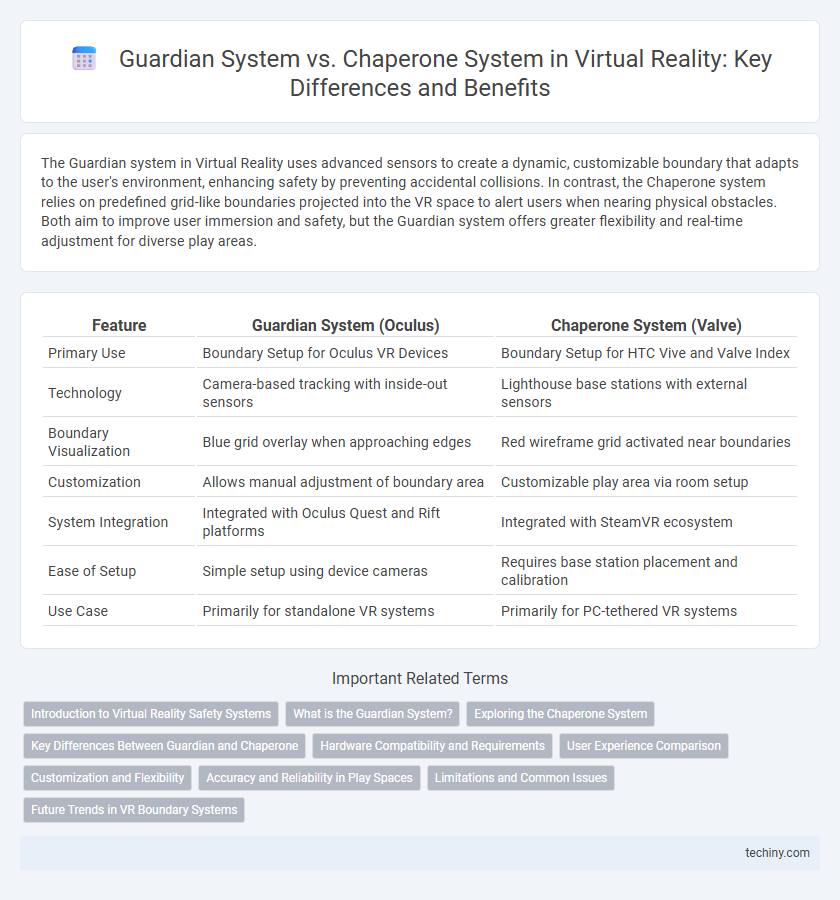The Guardian system in Virtual Reality uses advanced sensors to create a dynamic, customizable boundary that adapts to the user's environment, enhancing safety by preventing accidental collisions. In contrast, the Chaperone system relies on predefined grid-like boundaries projected into the VR space to alert users when nearing physical obstacles. Both aim to improve user immersion and safety, but the Guardian system offers greater flexibility and real-time adjustment for diverse play areas.
Table of Comparison
| Feature | Guardian System (Oculus) | Chaperone System (Valve) |
|---|---|---|
| Primary Use | Boundary Setup for Oculus VR Devices | Boundary Setup for HTC Vive and Valve Index |
| Technology | Camera-based tracking with inside-out sensors | Lighthouse base stations with external sensors |
| Boundary Visualization | Blue grid overlay when approaching edges | Red wireframe grid activated near boundaries |
| Customization | Allows manual adjustment of boundary area | Customizable play area via room setup |
| System Integration | Integrated with Oculus Quest and Rift platforms | Integrated with SteamVR ecosystem |
| Ease of Setup | Simple setup using device cameras | Requires base station placement and calibration |
| Use Case | Primarily for standalone VR systems | Primarily for PC-tethered VR systems |
Introduction to Virtual Reality Safety Systems
The Guardian system uses customizable boundary creation with visual and haptic feedback to prevent users from colliding with physical objects in virtual reality environments. The Chaperone system employs a grid overlay within VR headsets, alerting users when they approach predefined spatial limits to enhance safety. Both systems prioritize user awareness and accident prevention, but Guardian offers more flexible, user-defined boundary management compared to the preset configurations of Chaperone.
What is the Guardian System?
The Guardian System is a virtual reality boundary framework designed to protect users by defining safe play areas within VR environments. It dynamically creates virtual grid lines or walls that alert users when they are nearing physical obstacles, preventing collisions and injuries. Unlike the Chaperone system, the Guardian offers customizable boundaries with enhanced visual feedback and seamless integration across various VR platforms, ensuring a safer and more immersive experience.
Exploring the Chaperone System
The Chaperone system in Virtual Reality uses boundary visualization to prevent users from colliding with physical obstacles by projecting a grid when nearing predefined play area limits. Unlike the Guardian system, which offers customizable boundaries and immersive alerts, Chaperone operates with a simple visual feedback mechanism, enhancing safety during VR sessions without interrupting immersion. This system is integral to HTC Vive headsets, providing real-time spatial awareness and minimizing the risk of accidents within confined spaces.
Key Differences Between Guardian and Chaperone
The Guardian system in virtual reality uses physical boundary mapping with real-time visual alerts to prevent users from crossing safety limits, while the Chaperone system relies on a grid overlay within the VR environment to warn users when approaching predefined boundaries. Guardian offers more dynamic and customizable boundary adjustments suitable for varied play areas, whereas Chaperone provides a basic static boundary warning primarily designed for earlier VR setups. These differences reflect advancements in spatial awareness technology, making Guardian more adaptive and user-friendly for modern VR applications.
Hardware Compatibility and Requirements
The Guardian system is designed specifically for Oculus VR headsets, utilizing built-in sensors and cameras to map play areas without external hardware requirements. In contrast, the Chaperone system, native to HTC Vive, relies on external base stations and lighthouse tracking for spatial awareness, necessitating additional hardware for setup. Both systems demand VR headsets equipped with precise tracking capabilities but differ significantly in sensor dependency and installation complexity.
User Experience Comparison
The Guardian system provides a flexible, user-defined boundary that adapts dynamically to room layout changes, offering enhanced spatial awareness and fewer interruptions during VR sessions compared to the Chaperone system. Chaperone relies on predefined play areas with grid overlays that may trigger more frequent warnings, potentially disrupting immersion and causing user frustration. User experience data highlights that Guardian's minimalistic feedback improves comfort and safety perception, making it preferable for extended VR use.
Customization and Flexibility
The Guardian system offers extensive customization options, allowing users to define personalized boundaries with adjustable shapes and sizes for enhanced safety. In contrast, the Chaperone system provides a more rigid setup with predefined grid patterns that limit flexibility but ensure consistent boundary detection. Both systems prioritize user protection, but Guardian's adaptive configurations better accommodate diverse play spaces and preferences.
Accuracy and Reliability in Play Spaces
The Guardian system in virtual reality offers enhanced accuracy and reliability in defining play spaces through dynamic boundary creation that adapts in real-time to user movements, reducing the risk of collisions. In contrast, the Chaperone system relies on a fixed grid approach that can be less precise and may cause interruptions during gameplay when users approach boundaries. The Guardian system's advanced sensor integration ensures consistent environmental awareness, making it a more dependable choice for safe virtual experiences.
Limitations and Common Issues
The Guardian system in Virtual Reality often faces limitations such as inaccurate boundary detection in low-light environments and difficulty adapting to irregular room shapes, leading to user collisions. The Chaperone system commonly struggles with delayed updates and imprecise warning zones, causing users to misjudge safe play areas. Both systems can experience calibration errors and sensor occlusion, impacting overall user safety and immersion.
Future Trends in VR Boundary Systems
Future trends in VR boundary systems emphasize enhanced spatial awareness and adaptive safety features, with the Guardian system evolving to incorporate dynamic environmental mapping and AI-driven obstacle prediction. The Chaperone system is expected to integrate haptic feedback and biometric sensors to provide real-time alerts and immersive boundary reinforcement. Advances in machine learning and sensor fusion will enable both systems to create personalized, seamless VR experiences with minimal user interruption.
Guardian system vs Chaperone system Infographic

 techiny.com
techiny.com